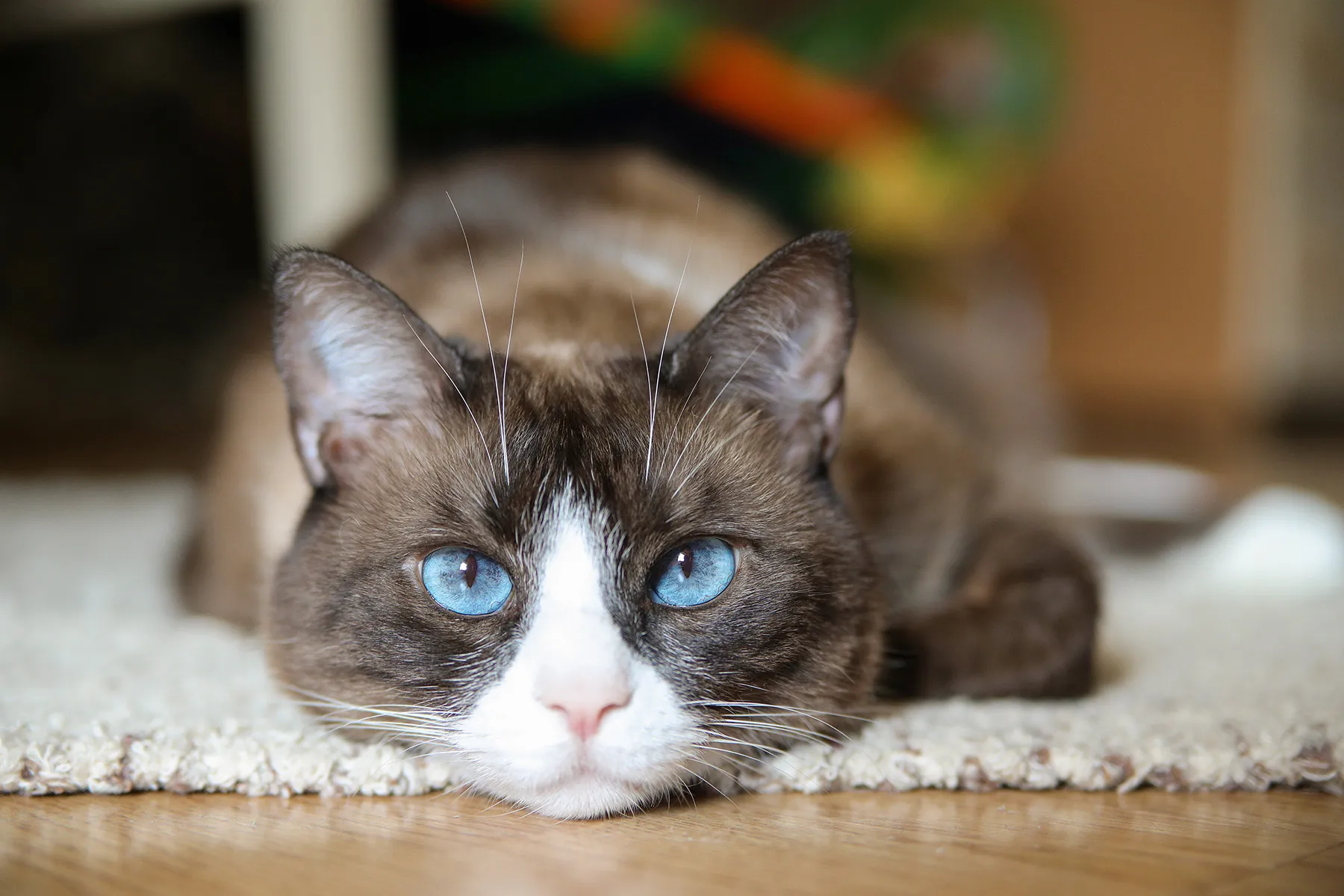
The Snowshoe cat is a relatively new breed of cat that draws on the physical, mental, and emotional qualities of both of its ancestors — the Siamese and American shorthair.
This breed is sociable, affectionate, playful, and intelligent and does well with both children and other animals, including dogs and other cats. This means that the Snowshoe cat is perfect for all types of homes and families.
Characteristics of the Snowshoe Cat
The Snowshoe cat's physical characteristics bring together traits from both of its ancestors. Much like the Siamese cat, Snowshoe cats are often born with a light-colored body, with darker points developing on the face, ears, and tail as they age. The Snowshoe is a medium-sized, short-haired cat with a single-layered coat that sheds only occasionally, which makes it especially easy to care for.
Although the body length of the Snowshoe is similar to the length of the Siamese, it has a more muscular and stocky build that can be attributed to the American shorthair.
The Snowshoe has two prominent features:
- An upside-down V shape between its blue, walnut-shaped eyes
- White paws with the white color frequently spreading up their legs, as if they're wearing white socks. This is where the breed gets its name.
Snowshoe cats can also have one of two different head shapes — triangular or apple shaped.
The Snowshoe cat size varies depending on gender as the females are generally smaller than the males. Their height can reach from around 8 to 13 inches and their weight can range from 7 to 14 pounds. The Snowshoe cat's lifespan is longer than that of the average cat on average, at 14 to 20 years.
In terms of the Snowshoe cat personality, the Snowshoe once again exhibits traits from both of its ancestors. Of course, no two Snowshoes will have the same personality. But regardless of which traits your Snowshoe ends up with, you can expect to never be bored.
Much like its Siamese ancestor, the Snowshoe will often form a strong connection to one person in the family. That’s not to say that they won’t be friendly and affectionate with multiple family members — because they will — but the bond they develop with their primary person will be special. The cat will desire to be near that person most of the time.
Some Snowshoe cats have a shy and withdrawn personality, whereas others have a more domineering personality. The latter are non-submissive cats that like to be in control. They often like to chat with their people and are active, curious, and affectionate creatures that are sure to keep their household amused.
Most of the time, Snowshoe cats will do well in households with other cats and dogs. But, sometimes, they'll prefer to be the only animal around so they can be the center of attention.
Caring for the Snowshoe Cat
The Snowshoe cat is low maintenance in terms of its grooming needs. In fact, these short-haired cats only need to be brushed twice a week to keep their coats looking tidy and healthy. Plus, this breed isn’t a frequent shedder, so you shouldn't be concerned about finding clumps of hair on your furniture or clothes.
Snowshoe cats require monthly nail trims to keep their nails healthy as well as daily tooth brushing. In addition, your Snowshoe cat's ears should be checked regularly and cleaned when needed.
Cats are typically prone to obesity, which can lead to several other health concerns. This means that an exercise regime is necessary to keep your cat in good health. It’s also important to provide your cat with a diet that's both healthy and appropriate for their age group. For the most part, Snowshoe cats should be fed a high-quality meat-based diet with an adequate amount of the amino acid taurine.
As for flea, tick, heartworm, and intestinal worm prevention, remember to keep your Snowshoe cat on monthly preventative care with medications that can prevent these infestations. Snowshoe cats, like most cats, can easily become infected with all sorts of nasty parasites. These infestations can occur from contact with unclean surfaces, drinking unclean water, or being bitten by mosquitoes.
Your veterinarian may also require a fecal exam of your Snowshoe cat twice a year to ensure that they are free of parasites.
Your Snowshoe should be kept up-to-date on routine core vaccinations that can protect them from diseases, such as panleukopenia, rhinotracheitis, calicivirus, rabies, and feline leukemia. You should also have your Snowshoe spayed or neutered when they're around 6 months old.
Health Problems to Watch for With Snowshoe Cats
Snowshoes are a relatively healthy breed that can live up to 20 years with proper care. But that doesn’t mean that they aren’t susceptible to certain types of diseases. Most commonly, Snowshoe cats have back problems, stomach discomfort, diarrhea, dental issues, and respiratory illnesses. They may also have a kinked tail or crossed eyes due to their Siamese lineage, but these issues are usually not a cause for concern.
There are a few other common diseases and illnesses that Snowshoe cat owners should be aware of. Common Snowshoe cat health problems include:
- Hypertrophic cardiomyopathy (HCM), or heart disease. This disease is often hereditary, but it can also show up as a secondary issue to another disease. It happens when the heart muscles thicken and is often the result of an overactive thyroid gland. Diagnosing heart disease early is vital. The symptoms you'll usually notice first are rapid breathing, lethargy, and a poor appetite. A heart murmur is also usually present, but more advanced imaging is required to obtain a specific diagnosis. Although there is no cure for HCM, medications can be prescribed to help manage the disease and slow its progression.
- Feline lower urinary tract disease (FLUTD). If your cat has started to relieve themselves outside of their litter box, it may be because they have FLUTD. Aside from this symptom, a cat with FLUTD may show signs of pain when urinating, straining to urinate, or blood in their urine. This disease can quickly become fatal, especially in male cats, whose urethra can become blocked. So it’s important to get your cat immediate medical attention if you notice the symptoms of FLUTD.
- Renal failure. Much like humans, cats are prone to diseases such as renal failure, or failure of the kidneys. This happens when the kidneys are unable to function properly. Renal failure mostly affects older cats, but it can affect kittens too — even more so if their parents had kidney problems. Because of this, you should make sure your Snowshoe is screened regularly for renal failure, especially if your cat may have inherited kidney defects.
- Allergies. Allergies in cats may show up differently than allergies in humans.They may also sneeze and have itchy eyes, but allergies often show up as itchy skin. This usually affects areas like their legs, stomach, face, and ears. If you notice excessive licking, or if your cat has had frequent ear infections, allergies may be the culprit.
Special Considerations for Snowshoe Cats
Thanks to their friendly and outgoing personalities, Snowshoe cats do well in households with other cats and dogs. Of course, they'll do what they can to get your attention as they love to have one-on-one cuddle sessions with their people.
The Snowshoe also does well in households with children, though supervision may be necessary when younger children are involved to make sure the children are treating the animal with respect. Because this breed does well with both children and other pets, this cat is perfect for households of all shapes and sizes.
These cats tend to draw on their Siamese ancestry when it comes to vocalization — they're frequent meowers and love to talk to anyone who will listen. However, unlike their Siamese ancestor, their voices tend to be on the softer side, making them an ideal option if you prefer a quieter home.
Despite being short-haired and having just one coat, Snowshoe cats are not hypoallergenic. However, that doesn't necessarily mean they'll cause allergy flareups. If you have allergies to animals, spend some time in the presence of a Snowshoe to find out how your allergies react before adopting a kitten or cat.
History of the Snowshoe Cat
The history of the Snowshoe cat dates back only to the 1960s when a woman by the name of Dorothy Hinds Daughtery discovered a litter of Siamese kittens — three of which had four white paws. Admiring the combination of white paws and pointed colors, Daughtery set out to establish the Snowshoe cat breed by breeding these kittens with an American Shorthair cat.
The offspring eventually developed prominent and unique V markings on their faces. Throughout the 1960s and 1970s, many breeders lost interest in the Snowshoe. But interest in the breed picked back up in the late 1980s, when there were around 30 registered breeders of Snowshoe cats.
The Snowshoe cat was given the title of a championship breed in 1994 by The International Cat Association, otherwise known as TICA.
Breeding cats with the specific markings of a Snowshoe — the V markings and white paws — is complex because the gene carrying these traits is recessive. Because of this, the Snowshoe cat breed has been deemed rare.


